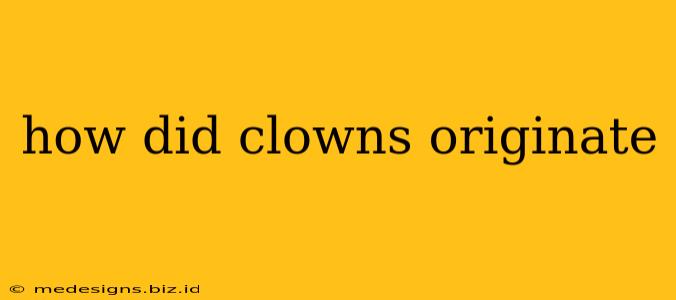The colorful, comical world of clowns has captivated audiences for centuries. But where did these masters of mirth and mayhem first emerge? The answer isn't a single event, but rather a fascinating evolution spanning different cultures and eras. Let's delve into the rich history of the clown, tracing their origins from ancient traditions to the modern circus.
Ancient Roots: From Rituals to Theatre
The very earliest forms of clowning can be surprisingly traced back to ancient civilizations. While not exactly the painted-faced, pie-throwing jesters we know today, elements of clowning can be seen in:
-
Ancient Roman Theatre: Characters known as stultus or moriones played comedic roles, often characterized by physical humor, slapstick, and witty dialogue. These performers were essentially the forerunners of the comedic actors we see in theatre today, laying the groundwork for the clown's comedic style.
-
Medieval Europe: During the Middle Ages, fools and jesters held a prominent place in royal courts and noble households. These individuals, often with physical deformities or mental impairments, provided entertainment through their wit, acrobatics, and sometimes even biting social commentary. Their unpredictable nature and willingness to challenge authority foreshadowed the rebellious spirit often associated with clowns.
-
Commedia dell'arte: This Italian theatrical tradition, flourishing from the 16th to the 18th centuries, heavily influenced the development of the clown archetype. Characters like Harlequin and Zanni, with their mischievous antics and exaggerated expressions, provided a template for many of the clown's physical and comedic characteristics. Their use of masks and improvisation also contributed to the clown's evolution.
The Birth of the Modern Clown: From Circus to Stage
The modern clown, as we readily recognize them, emerged primarily with the rise of the circus in the 18th and 19th centuries. The circus provided the perfect stage for these performers, offering a space for spectacle and exaggerated comedy.
-
Joseph Grimaldi (1778-1837): This British clown is considered a pivotal figure in the development of the modern clown. His energetic performances, innovative routines, and use of whiteface makeup helped shape the character we now associate with the traditional "whiteface" clown. Grimaldi's influence is still felt in contemporary clowning.
-
The Whiteface vs. Auguste: As the circus developed, two main clown archetypes emerged: the whiteface and the auguste. The whiteface clown is usually elegant and refined, while the auguste is more clumsy and mischievous, creating a dynamic comedic duo. This interplay of contrasting characters provided rich comedic opportunities.
The Evolution of the Clown: Beyond the Big Top
The clown's image has continued to evolve throughout the 20th and 21st centuries. Their roles have expanded beyond the circus, finding a place in:
-
Film and Television: Clowns have graced the silver screen, both as central characters and as supporting players, solidifying their place in popular culture. From silent films to modern animation, the clown has adapted to various mediums.
-
Street Performances: Street performers often employ clown characters to engage with passersby, adding a unique element of surprise and improvisation to their act.
-
Contemporary Circus: Modern circus acts frequently feature clowns who push boundaries, incorporating new styles and techniques while preserving the essence of clowning.
Conclusion: A Legacy of Laughter
From ancient rituals to modern entertainment, the clown's journey has been one of adaptation and evolution. While the specific origins are difficult to pinpoint, it's clear that the figure we recognize as the clown has emerged from a complex interplay of theatrical traditions, cultural influences, and the innovative spirit of talented performers. The clown's lasting appeal rests in their ability to evoke laughter, challenge social norms, and offer a moment of pure, unadulterated joy. Their legacy continues to inspire and entertain generations.
